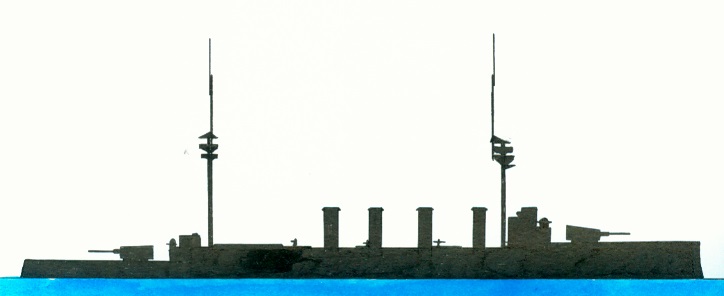Duke of Edinburgh-class armoured cruisers
Minotaur-class armoured cruisers
Invincible-class battle cruisers
Laid down at the Chatham Dockyard on 2 January 1905, launched on 20 September 1906, completed in November 1907, decommissioned on 2 May 1919, used as accommodation ship and finally sold to be broken up on 12 December 1922. British Minotaur-class armoured cruisers consisting of the Defence, Minotaur and Shannon, preceded by the Duke of Edinburgh-class but not succeeded by a new class of armoured cruiser, but in fact by the Invincible-class of battle cruisers. Not a really successful design while armour was offered to compensate the extra weight of their heavy armament.
Class specifications were: displacement 14.800-16.900 tons (deep load) tons and as dimensions 149,4 (between perpendiculars)-158,2 (over all) x 22,7 x 7,9 (mean) metres or 490-519 x 74.5 x 26 feet. The Shannon was 1 foot broader as her sister ships although her draught was one foot less. Crew numbered 779 (design)-842 (in service). Machinery consisted of 1 set 4-cylinder triple expansion steam engines with 24 Yarrow water tube boilers supplying via 2 shafts 27.000 (design)-27.372(trial) ihp allowing a speed of 22,324 (trials)-23 knots (design). Maximum coal bunker capacity was 2.060 ton to which 760 tons fuel oil were added to spread over the coal to increase the burning rate. Armour consisted of a 7,6-15,2cm/3-6” thick belt, a 3,8-5,1cm/1.5-2” thick deck with the gun turrets, barbettes and conning tower protected by respectively 11,4-20,3cm/4,5-8’, 17,8cm/7” and 25,4cm/10”. The armament consisted of 2x2-23,4cm/9.2” breech loading Mk XI guns, 10x1-19,1cm/7.5” breech loading Mk V guns. 10x1-7,6cm/3”/12pd quick firing 18-cwt guns and 5 submerged 4cm/18” torpedo tubes. Between 1915-1916 were for anti aircraft tasks 1-12pd gun and 1-3pd gun added. To prevent that the bridge was blinded by smoke were in 1909 the funnels raised. In 1916 was her foremast strengthened with legs due to the extra weight of the fir-control director , in 1918 was this foremast replaced by a tripod one.



